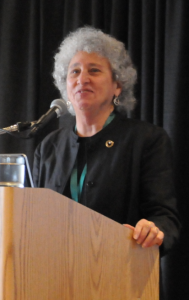 There’s nothing like a meeting of 200 or so Edible magazine publishers and staffers to focus attention on where the food movement is headed, how deeply it is taking root across the country, and how far we still have to go.
There’s nothing like a meeting of 200 or so Edible magazine publishers and staffers to focus attention on where the food movement is headed, how deeply it is taking root across the country, and how far we still have to go.
The annual Edible Institute held in Santa Barbara on March 16-17 attracted farmers, food writers, chefs and food activists from the general public as well as the growing community of nearly 80 locally-focused Edible magazines. The meeting a stellar line-up of experts who tackled many of the critical problems faced by our food systems today, including: obesity; food contamination; ocean acidification; farm labor; humane treatment of livestock and school lunches.
Keynote speaker Marion Nestle—an activist, nutritionist, NYU professor and author of many books on national food policy issues—praised the Edible magazines for focusing on food that is healthier for people and healthier for the planet. “People are desperate for values, and you represent values,” she told the group.
She then went on to explain how incessant demand for shareholder growth in the big food corporations is heavily to blame for the obesity epidemic. “Obesity rates started to increase in the 1980s with the deregulation of food marketing,” she said. In an effort to increase profits, food is now everywhere and portions are much larger than they were just 30 years ago.
 “It is very difficult to exercise personal responsibility in this environment, you just don’t stand a chance against large portions and sophisticated marketing,” she said. Nestle called for more government regulation of the food industry like the ban on supersized sugary soft drinks that New York City was trying to enact. “Menu labels, banning trans fats, media campaigns, they all work,” she said.
“It is very difficult to exercise personal responsibility in this environment, you just don’t stand a chance against large portions and sophisticated marketing,” she said. Nestle called for more government regulation of the food industry like the ban on supersized sugary soft drinks that New York City was trying to enact. “Menu labels, banning trans fats, media campaigns, they all work,” she said.
Nestle called California’s failed proposition 37 to label GMOs a game changer because it nearly passed, despite the $42 mil spent to defeat it. “With all the new GMO labeling initiatives springing up around the country, big companies will soon be begging for it,” she predicted.
Meat on Drugs
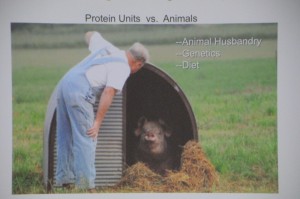 Contaminated produce and drug-laced meats were the targets of the first panel, which included Consumer Reports scientist Urvashi Rangan. She was one of the researchers behind a scathing 2012 report called “Meat on Drugs”, which documented the overuse of antibiotics in food animals. (link)
Contaminated produce and drug-laced meats were the targets of the first panel, which included Consumer Reports scientist Urvashi Rangan. She was one of the researchers behind a scathing 2012 report called “Meat on Drugs”, which documented the overuse of antibiotics in food animals. (link)
“We can take a harder line than government or industry groups, since we are independent,” explained Urvashi, who is also campaigning for stricter standards on salmonella in ground meat. “Up to 50% of ground chicken and ground turkey is allowed to contain salmonella in some supermarkets, including Walmart, while Costco doesn’t permit any salmonella in ground meats,” she said.
Urvashi lamented lax organic standards that allow apple and pear growers to use tetracycline and streptomycin to fight fire blight on varieties like fuji, gala and pink lady; as well as overuse of the word natural on food labels.
“Most people think natural means more than organic,” she complained. “We think the word natural should be banned from labels.”
Food Chains
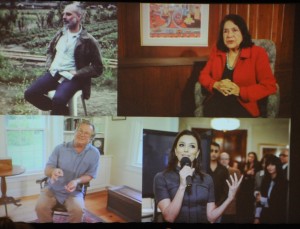 Filmmaker Sanjay Rawal screened a preview his documentary on the exploitation of farmworkers called “Food Chains”—slated for release this fall. In it, he examines tomato farms in Florida and strawberry fields in Watsonville and Moss Landing, showing how farm labor abuse is prevalent and how the backbreaking labor still leaves farmworkers in poverty.
Filmmaker Sanjay Rawal screened a preview his documentary on the exploitation of farmworkers called “Food Chains”—slated for release this fall. In it, he examines tomato farms in Florida and strawberry fields in Watsonville and Moss Landing, showing how farm labor abuse is prevalent and how the backbreaking labor still leaves farmworkers in poverty.
“One thing I remember about shooting in Watsonville was that while I was interviewing farmworkers living under a bridge, the Strawberry Festival was going on in the plaza and people were just oblivious to the living conditions of those who had picked that fruit,” Rawal said.
The film—narrated by actress Eva Longoria—includes interviews with authors Eric Schlosser and Barry Estabrook, as well as farm labor organizer Dolores Huerta. “There’s probably more interest in food right now than at any other time in our history,” says Schlosser in the film. “Yet there is a complete lack of interest in the people who bring us that food.”
Disappearing Oysters
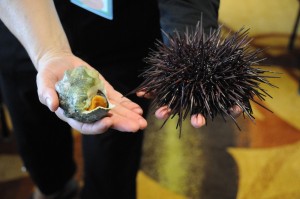 The problem of ocean acidification is beginning to show up in places where there is an upwelling of deep ocean water, like the Pacific Northwest and the Baltic Sea.
The problem of ocean acidification is beginning to show up in places where there is an upwelling of deep ocean water, like the Pacific Northwest and the Baltic Sea.
“This is not a climate change issue, but a greenhouse gas issue,” said marine biologist Gretchen Hofmann. “When carbon dioxide goes into the surface of the water, the reaction makes acid.”
Even slightly acidic ocean water prevents shellfish from making strong shells and the impact is already being seen on the oyster beds farmed by Taylor Shellfish in Washington State. Taylor farming and regulation director Bill Dewey tried to underscore his point by plying the editors with oysters and champagne. It worked!
“Oysters and shellfish are just the tip of the spear,” explained George Leonard of the Ocean Conservancy. “Even if you don’t care about oysters, this is important because little snails call pterapods are also affected and they are a huge food source for salmon and tuna.”
While ocean acidification is mainly caused by greenhouse gases, experts explained that fertilizer run-off from farms is also to blame. They agreed that controls on farm run-off would be a good first step towards solving the problem.
Some Bright Spots
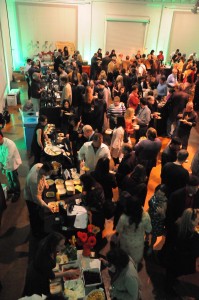 Despite all the doom and gloom, there was some positive news coming out of the Edible Institute. “Progress is being made,” said Cecily Upton, co-founder of FoodCorps—a branch of the national Job Corps dedicated to school food.
Despite all the doom and gloom, there was some positive news coming out of the Edible Institute. “Progress is being made,” said Cecily Upton, co-founder of FoodCorps—a branch of the national Job Corps dedicated to school food.
She cited examples of students complaining about microwaved bags of Cheetos with melted cheese that were being served for lunch at one school and about kids urging their friends to try kale salad because “they had grown it themselves in the school garden.”
Still, USDA regulations are complex and the feds only provide $2.86 per lunch under the national school lunch program, with lots of nutrition standards that need to be met. “Nationwide 32 million students participate in the free or reduced school lunch so by changing what is on those lunch trays we can have a huge impact,” she said.
“Institutional food is never going to be sexy, but that doesn’t mean it can’t be delicious,” Upton said, complaining about restricted budgets.
“Why is it that we expect lunch to cover its own costs?” she asked. “We don’t expect art to pay for itself or math. It’s just part of the school day.”
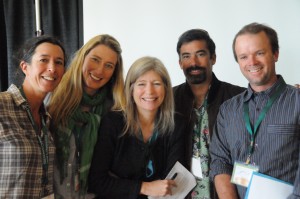 Another bright spot was the story of Paul Willis, a former Peace Corps volunteer who returned to run his family’s hog farm in Iowa and decided to do things differently. He raised his hogs out in the open air instead of cooped up in stinky barns, partly because he wanted to be outdoors and also because it is healthier for the animals.
Another bright spot was the story of Paul Willis, a former Peace Corps volunteer who returned to run his family’s hog farm in Iowa and decided to do things differently. He raised his hogs out in the open air instead of cooped up in stinky barns, partly because he wanted to be outdoors and also because it is healthier for the animals.
Eighteen years ago he teamed up with Bill Niman and founded the Niman Ranch Pork Company, which provides humanely raised, antibiotic and hormone-free, pastured pork to customers like Whole Foods, Chipotle Mexican Grill and Panera Bread.
The premium brand now includes 500 farms, with one or two coming onboard every week. “Some farmers tell me they would have gone out of business if not for us,” said Willis—who was the recipient of Edible Communities’ 2013 Founders Award.
 Driving home from the Edible Institute past the vineyards and row crops along Highway 101, it was easy to see how important the issues raised at the conference are for our own highly productive part of the United States. Perhaps what’s more surprising and encouraging is how relevant the issues were for attendees from all over the country. Between sessions I talked to people from Tucson who are trying to revive heirloom varieties of corn and to New Yorkers who are farming shellfish on the shores of Long Island. It’s inspiring and exciting to be reminded that the good food revolution is blossoming across the nation.
Driving home from the Edible Institute past the vineyards and row crops along Highway 101, it was easy to see how important the issues raised at the conference are for our own highly productive part of the United States. Perhaps what’s more surprising and encouraging is how relevant the issues were for attendees from all over the country. Between sessions I talked to people from Tucson who are trying to revive heirloom varieties of corn and to New Yorkers who are farming shellfish on the shores of Long Island. It’s inspiring and exciting to be reminded that the good food revolution is blossoming across the nation.
Photography is by Kurt Michael Friese
About the author
Deborah Luhrman is publisher and editor of Edible Monterey Bay. A lifelong journalist, she has reported from around the globe, but now prefers covering our flourishing local food scene and growing her own vegetables in the Santa Cruz Mountains.
- Deborah Luhrmanhttps://www.ediblemontereybay.com/author/dluhrman/
- Deborah Luhrmanhttps://www.ediblemontereybay.com/author/dluhrman/
- Deborah Luhrmanhttps://www.ediblemontereybay.com/author/dluhrman/
- Deborah Luhrmanhttps://www.ediblemontereybay.com/author/dluhrman/


